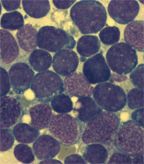Targeting GFI1 May Improve Prognosis in ALL, Study Suggests
Findings of a newly published study by an international team of researchers suggest that targeting growth factor independence 1 (GFI1) may improve the prognosis of patients with T-cell acute lymphoblastic leukemia or other lymphoid leukemias.
Findings of a newly published study by an international team of researchers suggest that targeting growth factor independence 1 (GFI1) may improve the prognosis of patients with T-cell acute lymphoblastic leukemia (T-ALL) or other lymphoid leukemias. Results were reported in the journal Cancer Cell.

Bone marrow smear (large magnification) from a patient with ALL; source: Furfur, Wikimedia Commons
Led by researchers at Cincinnati Children’s Hospital Medical Center (CCHMC) and the Institut de Recherches Cliniques de Montreal (ICRM), the study found that removing the GFI1 protein in mouse models of the disease weakened and killed the leukemia cells. If confirmed in clinical trials, the investigators said, this should make the leukemia more susceptible to chemo and radiation therapies-the current frontline treatments for ALL.
“Because oncogenic signaling activates a p53-dependent DNA damage response and apoptosis, leukemic cells must devise appropriate countermeasures,” they explained. They found that GFI1 can serve that function because GFI1 ablation exacerbates p53 responses and lowers the threshold for p53-induced cell death. “Specifically, GFI1 restricts p53 activity and expression of proapoptotic p53 targets such as Bax, Noxa (Pmaip1), and Puma (Bbc3).”
“GFI1 inhibition amplifies p53-dependent proapoptotic responses driven by oncogenic stress; consequently, transformed lymphoid tissues are uniquely susceptible to GFI1 inhibition,” explained H. Leighton Grimes, PhD, of the divisions of cellular and molecular immunology and experimental hematology at CCHMC. “In combination with current therapies, GFI1 inhibition may allow the use of lower cytotoxic doses, which would benefit patients directly.”
Grimes and Tarik Mry, PhD, scientific director of the ICRM in Montreal, were co-senior investigators of the study, which included researchers from the United Kingdom, Germany, the United States, and Canada.
Despite the great promise shown by molecular-based targeted therapies, they have lacked broad applicability due to the heterogeneity of oncogenic pathways mutated during transformation, the authors explained. “Here, we demonstrate that ablation of GFI1 broadly leads to lymphoid tumor regression and host survival independent of the transforming pathway.”
GFI1 has an important role in the normal development of lymphoid cells. But analyses of ALL mouse models and primary human tumors showed that GFI1 is overexpressed in the disease state, according to the investigators. “Our results indicate that leukemic cells in general require GFI1 because the ablation of GFI1 led to lymphoid tumor regression and host survival independently of the transforming pathway or tumor etiology,” said the investigators, adding that GFI1 may be an “oncorequisite” factor-a normal cellular protein upon which malignant cells uniquely depend for their survival. “This offers a different paradigm for cancer therapeutics and suggests that normal cellular proteins, independent of their mutation status in human tumors, can be excellent targets for clinical intervention.”
Further study is needed, however, to incisively define a role for GFI1 in human acute myelogenous leukemia (AML). The authors noted that HOXA9 signaling is present in mixed-lineage leukemia but is active in less than 10% of patients with T-ALL. “Patients with rare HOXA9-active T-ALL may not benefit from receiving GFI1-targeting therapies. Therefore, careful molecular pathology will likely be important to stratify patients for GFI1-targeted therapeutics.”
Nevertheless, they concluded, the main result from the study suggests that the goal of reducing chemotherapeutic or irradiation dose-and thus reducing their side effects while maintaining their efficacy-can be achieved by inhibiting the function of GFI1 in patients with T-ALL. “According to our data, leukemic cells lacking GFI1 will be more sensitive to DNA damage-inducing chemo- or irradiation therapy and undergo accelerated apoptosis. It is thus conceivable that targeting GFI1 will not only significantly improve response rates but may in particular allow lower effective doses of chemotherapeutic agents or irradiation.” The scientists are continuing their research to see if results of the current study will be translatable to human patients.
Funding for the research came in part from the National Institutes of Health, the Canadian Institutes of Health Research, the Canada Research Chair program, Leukemia and Lymphoma Society of America, CancerFree Kids, Alex’s Lemonade Stand, the German Cancer Fund, the Cole Foundation, a University of Cincinnati Cancer Therapeutics T32 training grant, and a Pelotonia Fellowship.